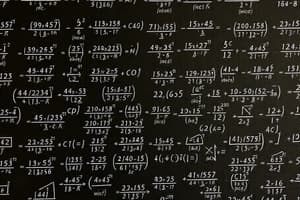Podcast
Questions and Answers
Addition is a basic arithmetic operation that represents the combination of two or more values to get a total or a ______.
Addition is a basic arithmetic operation that represents the combination of two or more values to get a total or a ______.
sum
The order of the numbers being added does not change the result, which is known as the ______ Property.
The order of the numbers being added does not change the result, which is known as the ______ Property.
Commutative
Addition can be distributed over ______.
Addition can be distributed over ______.
multiplication
The result of adding two or more numbers is known as the ______.
The result of adding two or more numbers is known as the ______.
A number being added to another number is known as the ______.
A number being added to another number is known as the ______.
The number to which another number is being added is known as the ______.
The number to which another number is being added is known as the ______.
Flashcards are hidden until you start studying
Study Notes
Addition
Definition
- Addition is a basic arithmetic operation that represents the combination of two or more values to get a total or a sum.
- It is denoted by the plus sign (+).
Properties
- Commutative Property: The order of the numbers being added does not change the result.
- Example: 2 + 3 = 3 + 2
- Associative Property: The order in which numbers are added does not change the result when more than two numbers are added.
- Example: (2 + 3) + 4 = 2 + (3 + 4)
- Distributive Property: Addition can be distributed over multiplication.
- Example: 2 + 3 × 4 = 2 + 12
Types of Addition
- Whole Number Addition: Adding whole numbers (positive integers).
- Example: 5 + 2 = 7
- Fraction Addition: Adding fractions (numbers with a numerator and a denominator).
- Example: 1/2 + 1/4 = 3/4
- Decimal Addition: Adding decimal numbers (numbers with a fractional part).
- Example: 2.5 + 1.8 = 4.3
Real-World Applications
- Counting objects: Adding the number of objects in different groups.
- Measuring quantities: Adding lengths, weights, or capacities of different objects.
- Financial calculations: Adding amounts of money.
Key Concepts
- Sum: The result of adding two or more numbers.
- Addend: A number being added to another number.
- Augend: The number to which another number is being added.
Addition
Definition
- Addition is an arithmetic operation that combines two or more values to get a total or sum, denoted by the plus sign (+).
Properties
- Commutative Property: The order of numbers being added does not change the result, e.g., 2 + 3 = 3 + 2.
- Associative Property: The order in which numbers are added does not change the result when more than two numbers are added, e.g., (2 + 3) + 4 = 2 + (3 + 4).
- Distributive Property: Addition can be distributed over multiplication, e.g., 2 + 3 × 4 = 2 + 12.
Types of Addition
- Whole Number Addition: Adding whole numbers (positive integers), e.g., 5 + 2 = 7.
- Fraction Addition: Adding fractions (numbers with a numerator and a denominator), e.g., 1/2 + 1/4 = 3/4.
- Decimal Addition: Adding decimal numbers (numbers with a fractional part), e.g., 2.5 + 1.8 = 4.3.
Real-World Applications
- Counting objects: Adding the number of objects in different groups.
- Measuring quantities: Adding lengths, weights, or capacities of different objects.
- Financial calculations: Adding amounts of money.
Key Concepts
- Sum: The result of adding two or more numbers.
- Addend: A number being added to another number.
- Augend: The number to which another number is being added.
Studying That Suits You
Use AI to generate personalized quizzes and flashcards to suit your learning preferences.



